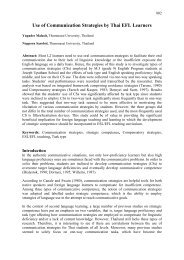The Effects of Semantic Mapping on Vocabulary Memorizing
The Effects of Semantic Mapping on Vocabulary Memorizing
The Effects of Semantic Mapping on Vocabulary Memorizing
Create successful ePaper yourself
Turn your PDF publications into a flip-book with our unique Google optimized e-Paper software.
vocabulary more effectively<br />
1. combining using the semantic mapping and the word list for<br />
memorizing vocabulary<br />
33.4%<br />
2. using the semantic mapping in reading less<strong>on</strong>s 22.2%<br />
3. giving a semantic mapping in Vietnamese as an example 11.1%<br />
4. requiring both English-Vietnamese dicti<strong>on</strong>ary and Vietnamese- 11.1%<br />
English dicti<strong>on</strong>ary for students<br />
5. adding some more pictures in the semantic maps 11.1%<br />
6. sticking students’ semantic maps in the classroom 11.1%<br />
Discussi<strong>on</strong>s, Pedagogical Implicati<strong>on</strong>s, Limitati<strong>on</strong>s, Suggesti<strong>on</strong>s for Further<br />
Research and C<strong>on</strong>clusi<strong>on</strong><br />
1. Discussi<strong>on</strong>s<br />
<str<strong>on</strong>g>The</str<strong>on</strong>g> main objective <str<strong>on</strong>g>of</str<strong>on</strong>g> this study was to find out whether or not semantic mapping had positive<br />
effects <strong>on</strong> students’ vocabulary memorizing. <str<strong>on</strong>g>The</str<strong>on</strong>g> original hypothesis <str<strong>on</strong>g>of</str<strong>on</strong>g> the study was that<br />
semantic mapping would help students memorize words effectively and result in students’<br />
positive attitudes. <str<strong>on</strong>g>The</str<strong>on</strong>g> results <str<strong>on</strong>g>of</str<strong>on</strong>g> the study revealed some important findings in the students’<br />
vocabulary retenti<strong>on</strong> and the students’ attitudes towards using semantic mapping.<br />
1.1 <str<strong>on</strong>g>The</str<strong>on</strong>g> students’ vocabulary retenti<strong>on</strong><br />
It can be seen that semantic mapping had positive effects <strong>on</strong> student’s vocabulary memorizing.<br />
<str<strong>on</strong>g>The</str<strong>on</strong>g> results from the pre-test indicated that the c<strong>on</strong>trol group and the experimental group had the<br />
same initial level <str<strong>on</strong>g>of</str<strong>on</strong>g> vocabulary knowledge. <str<strong>on</strong>g>The</str<strong>on</strong>g> results obtained from the post-test illustrated a<br />
significant change in students’ vocabulary achievement in the experimental group whereas the<br />
students’ vocabulary achievement in the c<strong>on</strong>trol group <strong>on</strong>ly slightly improved. This showed that<br />
there was improvement in the vocabulary test in both groups; however, the experimental group<br />
outperformed the c<strong>on</strong>trol <strong>on</strong>e.<br />
<str<strong>on</strong>g>The</str<strong>on</strong>g> results was c<strong>on</strong>sistent with the research c<strong>on</strong>ducted by Margosein, Pascarella and Pflaum<br />
(1982), Vogt (1983) and Pikula (1987) who found that semantic mapping had a greater impact <strong>on</strong><br />
vocabulary acquisiti<strong>on</strong>. However, the studies carried out by the previous researchers compared<br />
the effectiveness <str<strong>on</strong>g>of</str<strong>on</strong>g> the semantic mapping and other techniques (c<strong>on</strong>text clue approach, the<br />
traditi<strong>on</strong>al dicti<strong>on</strong>ary-definiti<strong>on</strong>-plus-example approach, or the dicti<strong>on</strong>ary). In this study, the<br />
researcher compared the effectiveness <str<strong>on</strong>g>of</str<strong>on</strong>g> the semantic mapping and that <str<strong>on</strong>g>of</str<strong>on</strong>g> the word lists.<br />
One reas<strong>on</strong> for helping vocabulary memorizing could be the semantic mapping’s effectiveness in<br />
visually integrating new words with old <strong>on</strong>es and promoting a deep level <str<strong>on</strong>g>of</str<strong>on</strong>g> semantic processing.<br />
Hague (1987) and Machalias (1991) stated that “meaningful exercises or classroom activities<br />
which promote formati<strong>on</strong> <str<strong>on</strong>g>of</str<strong>on</strong>g> associati<strong>on</strong>s and therefore build up students’ semantic networks are<br />
effective for l<strong>on</strong>g-term retenti<strong>on</strong>” (Hague, 1987; Machalias, 1991, cited in Sokmen, 1997, p.<br />
249). Moreover, according to Schmitt (2000), presenting items to students in a systematized<br />
manner which will both illustrate the organized nature <str<strong>on</strong>g>of</str<strong>on</strong>g> vocabulary and at the same time enable<br />
students to internalize the items in the coherent way. Actually, the semantic mapping helped<br />
653






